This airport development programme is financed by :

Project conception
According to the law on energy transition and green growth, Reunion should be energy self-sufficient by 2030. In this field, our island is already a leading pioneer, and the restructuring of Reunion’s Roland Garros Airport is one key part of this drive. The environmental necessity is just as important as that of new needs resulting from increased passenger traffic.
The design strategy for this building clearly reflects the environmental goal of decarbonising our activities here at the Société Aéroportuaire, based on the following concepts:
- - Making the most of the wind available on site to avoid the need for air conditioning, thanks to the layout, architecture and the building’s openings (tested in a wind tunnel).
- - Reducing solar heat gain while encouraging natural lighting
- - Controlling climate management (regulation, air fans, etc.) and user comfort
- - Creating cooler areas thanks to nearby green spaces, thus lowering the temperature of the surrounding environment,
- - Optimising storm-water management while developing biodiversity endemic to Reunion
The increase of international flights and the further development of tourism will result in the airport welcoming nearly 3 million passengers each year by 2030. Alongside this increase in traffic, European regulations require airports to equip themselves with Standard 3 hold baggage detection systems, a baggage screening device comparable to MRI systems used in medicine. In order to offer the highest level of hold baggage security to its passengers and comply with these regulations, the NAO (New West Terminal) will boast a fully overhauled baggage handling system (BHS), including the acquisition of two new Standard 3 tomography machines (CT scanners) in addition to the existing one.
As a result of this growth in traffic and new security standards, Reunion’s Roland Garros Airport launched the New West Terminal project. In addition to complying with European norms and providing a new area dedicated to arrivals, the baggage delivery area is bioclimatic and naturally ventilated.
This choice is an integral part of the Sustainable Development approach inherent to all projects at Reunion Island’s Airport. Air conditioning is the main energy use in our humid tropical environment, which has led us to reduce its usage whilst still maintaining user comfort thanks to natural ventilation - due to its location and surroundings, the airport benefits from considerable high wind potential. The air-conditioned surface area of this project is less than 10% of the total surface area of the building (7%!). Compared with the existing building, energy savings amount to 60% - this energy saving alone is the equivalent of the annual electricity consumption of more than 500 Reunionese households.
KEY FIGURES
13,200 m² of floor space created
3,900 m² of existing space restructured
745 m3 of timber (structural and non-structural)
7,000 m3 of concrete
580 t of steel framework
A €65m bioclimatic building including a new €15m baggage handling system (including both departing and arriving luggage)
Capacity to handle more than 3.16 million passengers per year by 2035 (currently the maximum handled is 2.4 million)
A works contract divided into 19 batches
First delivery milestone in 2024
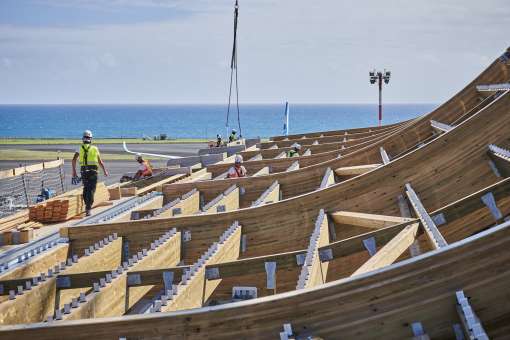
Project management
Owner: AEROPORT DE LA REUNION ROLAND GARROS
Architect: AIA LIFE DESIGNERS
Associate architect: OLIVIER BRABANT
Authorisations, Supervision and Coordination: SETEC / PLANITEC BTP
Project management: ICADE / SODIAC
Engineering and economics: AIA Ingénierie
Structural engineering: VRD INCOM
Fluid engineering: INSET
Environmental expertise: AIA Environnement
Baggage handling system engineering: AD-ET
Pavement design, aeronautical and works supervision: CEREMA
Acoustics: TYSSEYRE + Associates
Landscape: ATEA
Regulatory studies: ENVIROTECH
Aerodynamics, ventilation: JACQUES GANDEMER
Control office: Veritas
Health & Safety: Veritas
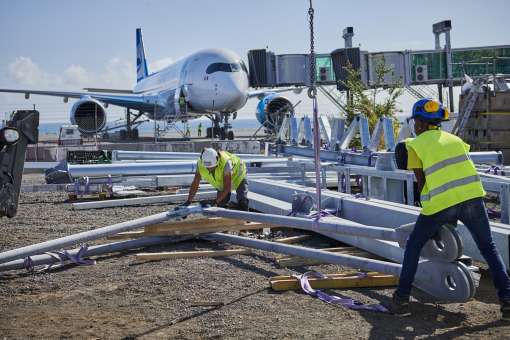
Companies
Structure, roofing & waterproofing : SBTPC SOGEA REUNION / ARBONIS / CANCE REUNION
Earthworks: VRD GTOI / INEXENCE REALISATION OCEAN INDIEN / SOLTEC
Cladding & metalwork: CANCE REUNION SARLE / SMAC OI
Lining, partitions & ceilings: SOREPLAC
Painting: SAM PEINTURE
Aluminium joinery & automation: CANCE REUNION / CANCE SA
Wood joinery, fixtures & fittings: SOREPLAC
Air conditioning, ventilation & mechanical smoke extraction : TUNZINI OCEAN INDIEN ENSEIGNE / CEGELEC LA REUNION
Sanitary & plumbing system: RIA AXIMA CONCEPT
Ventilation systems: ATEXIA / ENERGIE CONCEPT
High voltage: COREM
Low voltage: ATEXIA
Landscaping: LA MARE ESPACES VERTS
Aeronautical areas: GTOI
Flooring, soft & hard walls: LUCIDITE
Plumbing & fire-hose stations: AXIMA CONCEPT
Safety equipment: Groupement ATEXIA / SETB ACTEMIUM
Fire safety systems : SATELEC / SATELEC CENERGI
Baggage handling system: Groupement EQUANS ( Fabricom ) / ALFYMA / COFELY
Explosive Detection System : SMITHS DETECTION
Completion of structural work
Civil engineering works on the NAO (New West Terminal) site were completed at the end of May, after having poured the concrete for the top floor of level 0.
The New West Terminal building will be comprised of two sections. The lower level is a reinforced concrete structure, while the upper level is structure made of both wood and metal, complete with a façade of tilting louvres that serve to boost the efficiency of natural ventilation inside the arrivals hall.
The civil engineering works to build the New West Terminal began in November 2021, and were completed at the end of May 2022, following completion of work on the top floor of level 0. It took two months of preparing the site before any works could take place. The initial earthwork removed between 40 cm and 1.5 m of material, depending on the area and its geological characteristics, in order to find the right soil with sufficient load-bearing capacity.
Civil engineering work began in January 2022, after the construction industry’s annual break. The soil was covered with technical backfill, before the concrete slab was laid and the cranes erected, which took place in mid-February 2022. The first formwork elements for the floor were installed at the beginning of April 2022, then the pouring of concrete began on the side facing the mountain, and this then spread out progressively towards the runways. This was completed at the end of May 2022, bringing the civil engineering phase to a close.
One particularly delicate stage in the structural work involved the installing of the inclined columns within the load-bearing structure on level 0. These parts improve the building’s wind resistance and guarantee the building's stability in the event of an earthquake. 16 of these 7.60 m long posts were prefabricated in a factory in Le Port, then transported to the site, where they were placed on steel supports.
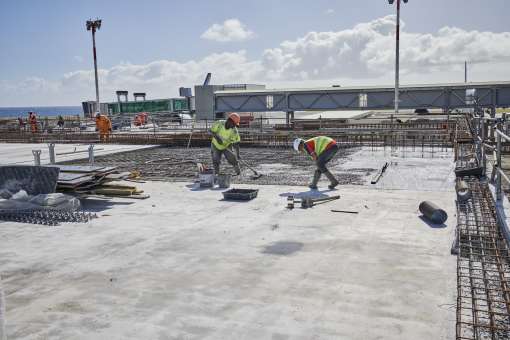
Airport safety always comes first
Very strict safety rules apply to the New West Terminal building site, which in turn has required changes to certain air traffic regulations.
Patrick Lacaille, Head of Airport Safety at Reunion’s Roland Garros Airport, was tasked with studying the construction project’s impact on the airport’s daily operations and this well before work began. He first drew on the expertise of the Local Runway Safety Team, which brings together all types of pilots using the airport, to draw up risk reduction measures that were subsequently approved by the Civil Aviation Safety Directorate (DSAC). In addition, all employees working on the site have been made aware of the safety rules applicable to any operational airport.
“Particular attention was paid to the risk of FOD (Foreign Object Debris)”, explains Patrick Lacaille, “in order to avoid any mud or projectiles being thrown onto the runways”. To do this, a clear space of 3 metres wide was created all around the edge of the site, on the seaward side. The crane closest to the parking areas was even modified so that the belt attached to its main arm would never hang directly above any vehicles on the runway.
The presence of the tower cranes, two considerable obstacles likely to hinder the manoeuvring of any aircraft in difficulty, also led to a change in the minimum altitude at which pilots decide whether or not to land. In addition, these two tower cranes actually generated interference for radio-navigation systems, particularly in a south-westerly direction. This meant that the use of these devices by aircraft had to be restricted for the duration of the construction work.
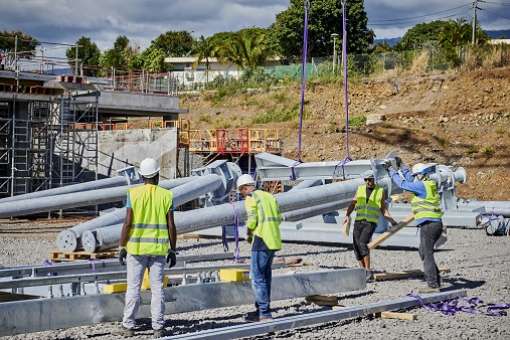
Installing a natural ventilation system
The facades of the new terminal, which will be completed in March, are made up of a combination of glass walls and adjustable slats that will ensure the building's natural ventilation.
The architecture of the NAO (New West Terminal), designed by AIA Life Designers and Olivier Brabant, is based on bioclimatic principles. It takes full advantage of local weather conditions to reduce the building's energy consumption while still guaranteeing comfortable temperatures inside. In this case, the choice was made to exploit the airport's almost constant north-easterly winds to naturally ventilate the new terminal.
The system chosen aims to evacuate heat while lowering the temperature as perceived by the human body by several degrees. To achieve this, the building has been positioned towards the prevailing winds, and parts of its facades are made up of louvres, adjustable slats that allow air to pass through, and a ‘canyon’, the structure's in-built ventilation pump running lengthways along the depression set into the roof.
In this way, wind will be able to freely enter the terminal building, cooling the atmosphere inside before escaping out from the top via the ‘canyon’ and the opposite façade, which is also equipped with louvres. When there is insufficient wind, large fans take over. Only a few technical rooms and offices, which are closed for operational or safety reasons, will use assisted air conditioning.
A number of measures have also been taken to prevent rain from entering the building, which could be possible when combined with strong winds. Roof overhangs limit this risk, as well as reducing solar gain, and a railing will also be installed along the interior facades to protect the general public from getting splashed, and also to prevent children from getting their fingers caught in the louvres.
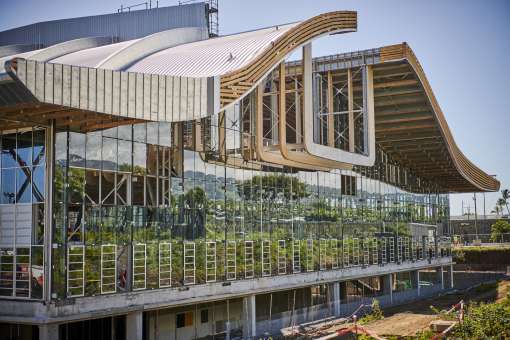
Baggage handling: 3D security scans
At the same time as the baggage arrival route is taking shape in the new terminal, a new baggage handling system for departures is being installed under the existing terminal.
The construction of the new arrivals terminal has freed up considerable space on the existing terminal’s lower level, enabling Reunion’s Roland Garros Airport to be equipped with a baggage handling system that complies with the latest European norms.
EU regulations require all departing baggage to be screened for explosives using an EDS (Explosive Detection System) scanner from 1st March 2024. Before that date, all baggage was screened using conventional X-ray equipment, with only suspect baggage being examined using a CT scanner. The investment in this new baggage handling system (BHS) represents a cost of €15 million. The installation of two conveyor lines, two CT scanning machines (each weighing 8 tonnes) and baggage carousels is nearing completion. No fewer than 440 motors are fitted to these conveyor belts, which form a complex circuit enabling the contents of the suitcases to be inspected without stopping the conveyors. If the machine deems any suitcase suspicious, it will be automatically routed to a secondary circuit running at a slower speed. An operator then carries out a 3D scan of the luggage, which is then returned to the main circuit if there are no doubts. If not, it is sent for a final check, which may result in the bag being opened in the presence of the passenger.
Departing baggage will end its journey on the runway level under the new terminal, from where it is conveyed to the aircraft. The arrivals hall of the new terminal is equipped with three baggage carousels, fed from the lower level.
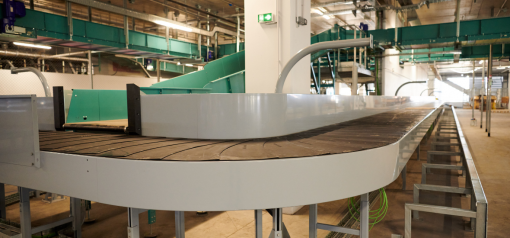
Lancement du chantier de la Nouvelle Aérogare dédiée aux arrivées
-
Dossier de presse
-
Télécharger
-
Communiqué de presse
-
Télécharger
-
Photos de l'évènement du 7/10/21
-
Y accéder
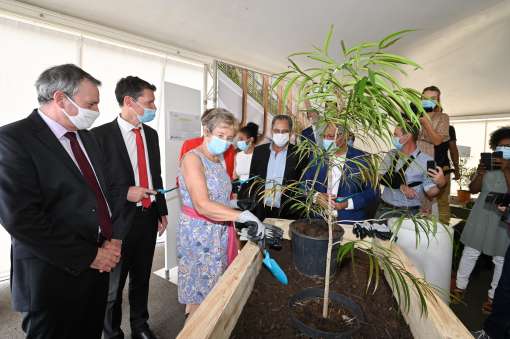
A hollow-core floor to save on concrete
The floor of the New West Terminal was built using a hollow-core construction method, an innovative technique that has saved on concrete, thus reducing the size of the beams supporting it.
The New West Terminal will be on one single floor, covering level 0, which will be walked on by passengers collecting their baggage on arrival. The structure was initially planned to be made of traditional reinforced concrete, before SBTP-SOGEA, the company in charge of the structural work, proposed a hollow-core solution to the airport. This technique, which is currently being developed in Europe and has only been used once in Reunion (at the Decathlon shop in Commun Primat), involves placing hollow plastic caissons within the floor structure itself. This saves on concrete, reducing not only the weight of the floor but also the size of the beams between the load-bearing columns. This considerable reduction in the number of floor-supporting beams is also a considerable advantage when the building is in use, as it makes it much easier to gain access to the various networks already connected under the floor.
What's more, this method of construction is also quicker to install than when pouring concrete for a traditional floor, and the estimated saving in concrete is 140 m³.
The terminal floor boasts another special feature: it has not been given any cladding, leaving a smooth concrete surface with a rough, mineral appearance. To ensure its durability and longevity, the surface has been coated with a protective layer of quartz powder in order to harden the top layer of the slab, which will be walked on by passengers and their baggage trolleys. As the floor is polished over time, it will take on a uniform mineral sheen.
The happy blend of wood and metal
The terminal building’s metal structure and wood framework form an integral structure that requires considerable accuracy and precision to assemble.
Assembly of the New West Terminal’s metal structure began at the end of May, as soon as the concrete shell had been completed. This operation coincided with the lifting and erection of the glulam timber frame elements, which began in mid-August. In this way, the building spread out in one direction, from the mountains towards the sea. The crossbeams (the structure’s main beams, recognisable by their curved shape) are 2.50m high and can be up to 25m long. Because of their size, some of these sections were stored on site, but not all of them. Some of them would be delivered to the site in the early morning by a special convoy, after which they were assembled on the ground and then lifted into place by one of the two cranes. Initially held in place with temporary mooring ropes, the beams were then fixed to the structure, to the nearest centimetre, by a team in position on a platform lift. The beams were then connected using a combination of wood and metal elements.
At the end of August, assembly of the secondary framework began on the mountain-facing side of the building. It is made up of purlins and wind-bracing elements, made of wood and metal, on which the rooftop was then laid. The first sheets of aluminium that will make up the roof of the New West Terminal will be installed at the end of September.
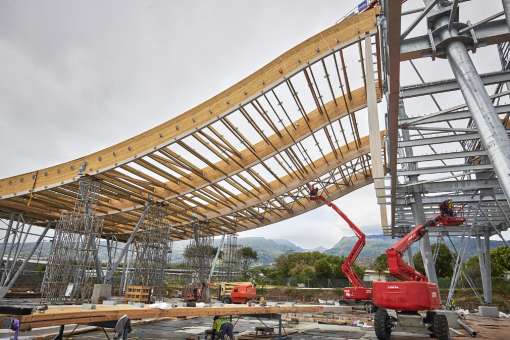
Automatically piloted ventilation system
The new terminal’s natural ventilation will be controlled by a set of automatic systems, based on weather data transmitted in real time by two stations.
Inside the new terminal, comfortable temperatures will be ensured thanks to automatic systems that a) will regulate the opening of the facades and b) activate the air fans depending on weather conditions. Two weather stations will be installed in the existing terminal in order to provide real-time information on wind direction and rainfall.
Each set of louvres will be fitted with a connected motor that can tilt the louvres at varying degrees in order to generate the desired air flow and also ensure that inside air is constantly renewed, which is of course essential for health reasons.
Particular attention will be paid during the winter months: the trade winds that blow steadily during our austral winter can also be a source of discomfort if they cause the interior ventilation to be either too strong or too cold.
The autopilot may be switched to manual mode, for example during a red alert cyclone warning period. All openings are then fully closed, with no impact on interior comfort given that all terminals are closed to the public during a red alert.
This first year of operation in 2024 will provide an opportunity to carry out any adjustments to parameters which will have resulted from the wind tunnel tests. In the absence of other references around the world, Roland Garros Airport will be a pioneer testing centre, a demonstration of bioclimatic design that should attract the attention of any infrastructure wishing to reduce their own environmental impact.
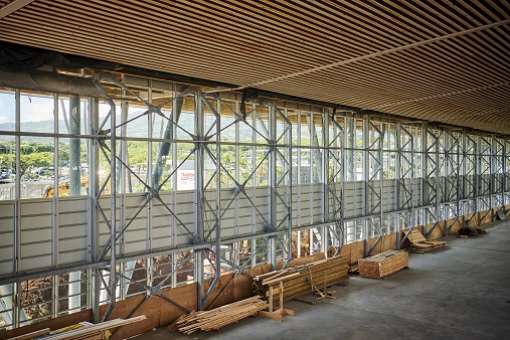
Secure IT architecture
Largely automated, the new baggage handling system is based on an IT architecture designed to ensure operational continuity in all circumstances.
Optimal baggage flow management is one of the most important components of any airport's quality of service. To guarantee this, a number of measures are taken right from the initial design stage of every baggage handling system: given that the system is highly computerised, a wide range of security measures are built into the IT architecture. The barcode which identifies each bag is read automatically by machines positioned along the circuit, so that it can be tracked from the beginning to the end of the conveyor chain and its contents checked. Numerous interfaces have been created between the BHS information systems, the Société Aéroportuaire and the airlines.
Security solutions implemented were defined in close consultation between the ALFACO consortium and Société Aéroportuaire's information systems department. The computer servers for the baggage handling system are doubled up, hosted in two data centres at Reunion’s Roland Garros Airport. A fibre optic network has been specifically deployed to guarantee the continuity of the flow of information between these servers and the computer rooms housing the various switches that enable the IT equipment to communicate with each other. BHS is also subject to the latest cybersecurity regulations, whose requirements have been incorporated into the project specifications.
Implementation of the system was entrusted to the ALFACO consortium, made up of the following specialist European companies:
- ALFYMA (engineering and supply of mechanical components, including engines) and its subcontractor CDNI for implementing mechanical elements);
- EQUANS (leader of the consortium supplying electrical and automation components, electrical engineering, IT, automation, integration and implementation of electrical and automation parts, responsible for integrating the entire system), and its subcontractor MDM (Maintenance Des Mascareignes, who supply some of the electrical equipment and implement the project’s electrical aspects).
- COFELY (technical operation and maintenance)
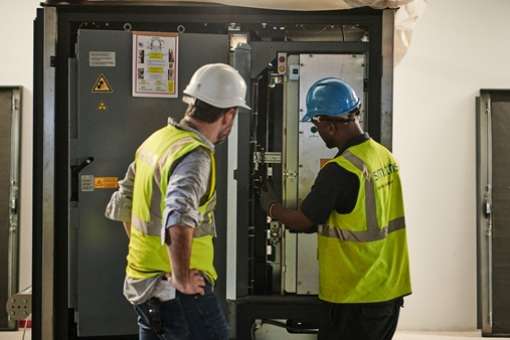
Two cranes in the sky over Roland Garros
The two tower cranes erected on-site during the week of 14th February 2022 were designed to be able to lift heavy loads at the end of their jibs. Identified as G1 and G2, they have jibs of 60m and 52m respectively.
It was the weight of specific structural elements (installed at the end of May 2022) which dictated the dimensions of the two tower cranes installed on the NAO site. During the civil engineering phase, they were used to lift the formwork, the prefabricated structures and the bucket used to pour the concrete. Their presence required a change in landing procedures by the Civil Aviation Authority. Pilots were also informed that the signal from radio-navigation instruments must not be taken into account within the radius of the cranes. Each crane was also fitted with three red lights on its jib, which are lit up every night as required by aviation regulations.
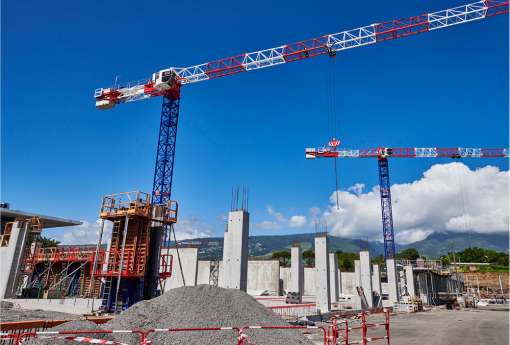
Wednesday visitors
Tours of the New West Terminal site are organised every Wednesday for members of the airport community who request it.
Every Wednesday morning brings its fair share of visitors to the site of the future NAO (New West Terminal). On this day, members of the airport community are invited to go behind the scenes and discover the features of the main construction site, under the guidance of the airport's NAO team. A signposted route is set up every week, depending on the progress of the works, to ensure everyone's safety.
Personal protective equipment (PPE) is provided, and up to 10 people are accepted per visit. Demand is high, with several visits sometimes taking place in the same morning. Applications should be sent to: direction.nao@reunion.aeroport.fr
In line with the Group's strong desire to promote the NAO project to as many people as possible, visits are also planned for school groups with links to the world of construction and public works, such as the CAP and BAC PRO classes at Lycée Jean Hinglo in Le Port who came on 18th August 2022. Aviation and tourism professionals have also benefited from these visits.
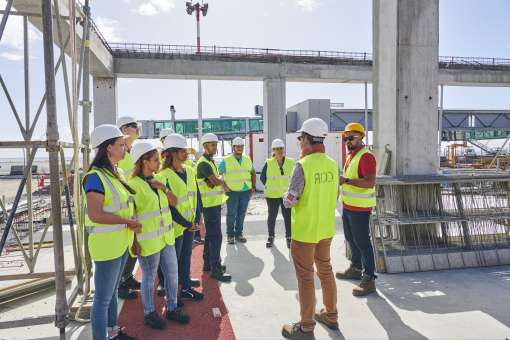
New premises for baggage complaints
During construction work, the baggage complaints room was moved to the arrivals hall of the existing terminal.
The current terminal and future west terminal will be linked by a corridor that will lead arriving passengers to the future baggage reclaim area. The construction of this corridor required the prior demolition of the baggage complaints room in the existing arrivals hall. To replace it, new premises have been built near baggage conveyor C3 (the closest to the exit) to accommodate teams from Air Austral, RAA and Samsic who are tasked with handling these complaints. The date of the works was chosen so as not to disturb the population of Mauritius tomb bats, a protected species that has taken up residence in the roof of the terminal.
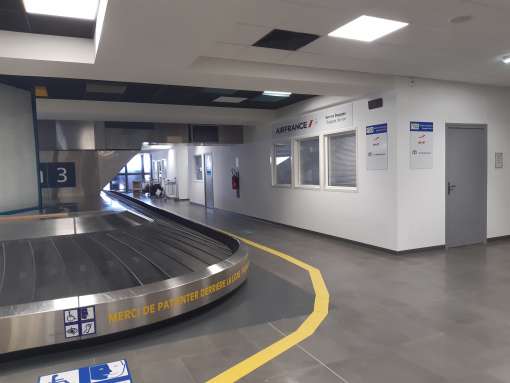
School visits
Every Wednesday, secondary school pupils, apprentices and students visit the site, where they can find out more about construction and civil engineering trades for the young people of Reunion Island.
Société Aéroportuaire encourages young people from all over Reunion to come and visit the New West Terminal worksite, a showcase for local construction expertise that is also attracting the interest of many professionals. Throughout the 2022-2023 academic year, secondary school pupils, apprentices and students have been regularly welcomed to the site and given guided tours by supervisors from the airport's NAO department, following a secure route at the foot of the cranes.
The construction of the terminal will also be one of the projects highlighted at the end of October during the ‘Behind the scenes of the construction industry’, an annual event organised by the Reunionese Construction Federation, aimed at highlighting different professions to young people
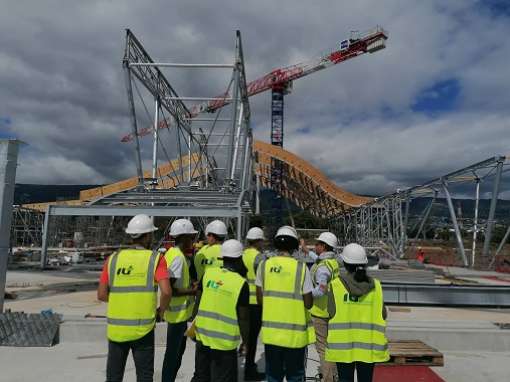
Terminal roofing completed
Started last October, the installation of the new terminal roof was completed at the end of February, on schedule.
The new terminal building has been waterproof since the end of February. The roof was fully completed after four months of work, interrupted by the construction industry's annual break. An innovative process was used, developed by the German company Kalzip. This involved laying sections of reconstituted aluminium 60cm wide and up to 40metres long, raised using a special spreader, and bent and crimped at highly precise angles. This process reduced the number of roof fixings to the structure and cut installation time. Zinc was used on part of the roof, on the edges and undersides visible from the ground in order to maintain architectural consistency with the existing terminal.
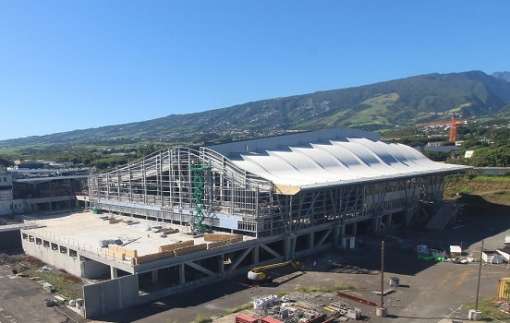
On camera for RMC Découverte
The construction of the terminal will be featured in a 52-minute documentary on French airport construction sites, to be broadcast shortly on RMC Découverte.
At the end of January, Reunion’s Roland Garros Airport welcomed journalist Clémence Rabeau, commissioned by RMC Découverte to produce a 52-minute documentary on a number of airport projects underway in France. The episode will include the construction of a new concourse lounge at Marseille-Provence airport and the creation of a new control centre at Nice-Côte d'Azur airport. “For me, the construction of this new bioclimatic terminal was one of the most interesting subjects of this episode”, says Clémence Rabeau. “I found the project both beautiful and ingenious, taking advantage of local weather conditions to cool the building naturally”. The director worked with two local professionals, a cameraman and a drone operator. Editing will be completed in April.
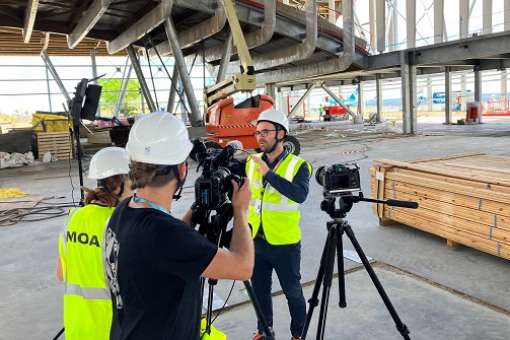
The final stages of the project
As 2023 draws to a close, work on the new terminal is nearing completion. The official opening is scheduled for February 2024.
In November 2023, a large number of companies are still hard at work on the premises of the new terminal, installing the latest equipment and programming the IT systems. The finishing touches are coming along nicely in preparation for the safety commission’s visit on 12th December. The facilities will then be handed over to the Société Aéroportuaire who will carry out full-scale tests to ensure that the equipment and procedures are all working properly. The arrivals terminal is scheduled to open in February. However, it won’t necessarily be fully completed, as work will continue on the lower level of the departures terminal to continue replacing the baggage conveyors between the check-in counters and the new conveyors, and this work will continue until November 2024. During next year, the Border Police checkpoints will also be moved to the current baggage delivery area, where the carpets will be removed to allow for a future extension of the departures lounge.
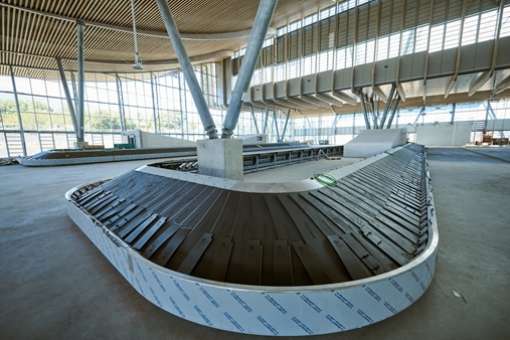
The new terminal has already won an award
The new terminal project has just won a national award (Grand prix de l'ingénierie) and an international award from ACI Africa.
On 26th October in Paris, AIA Life Designers was awarded the GPNI (Grand Prix National de l'Ingénierie) for its design of the new terminal building at Reunion’s Roland Garros Airport. Coordinated by professional engineering federation Syntec, the jury for this competition praised the project’s bioclimatic design, making it the first naturally ventilated airport building of its size anywhere in the tropics. Every year since 2006, the GPNI is awarded to a team that has competed in the design of an outstanding industrial or construction project. Reunion’s Roland Garros Airport also received international recognition at the 70th ACI Africa (Airports Council International) conference in Dakar on 17th October: an Environment and Sustainable Development Award in recognition of innovative initiatives led by its members.
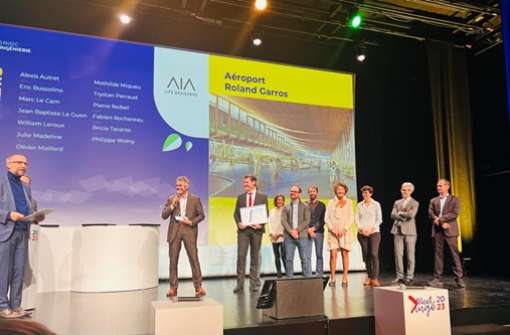
Craftsmen & women #1
Immerse yourself in the life of a truly unique construction site alongside the men and women who are putting all their expertise to good use during the construction of the New West Terminal.
Episode 1 of your new series dedicated to construction sites is now available!
Craftsmen & women #2
In this second episode dedicated to the construction work, learn all about the roles of those men and women working to ensure safety on-site.
Craftsmen & women #3
In this third episode, find out more about the people who designed the arrival terminal’s bioclimatic system.
Craftsmen & women #4
In this 4th instalment of the Craftsmen & women series, find out more about the people who worked to set up the new baggage handling system in the new Arrivals terminal.
Craftsmen & women #5
In this 5th and final episode of "Les artisans du voyage", find out what our managers have to say about this fine architectural project: the new arrivals terminal.
An innovative, modern design in the heart of the airport.
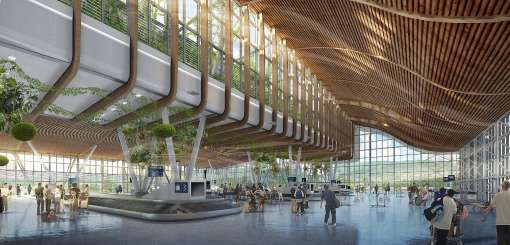
Equipped with adjustable motorised louvres, the new terminal’s opening façade will let in air from the outside. As it warms inside, this air will then be evacuated through openings on the sea-facing wall and also through a central ‘canyon’, a longitudinal, plant-covered structure separating the two sides of the roof. The wind will follow the curved shape of the roof, then be redirected upwards by air deflectors, creating a depression in the canyon and consequently drawing the air from the arrivals terminal. It is this air movement that will create a feeling of comfort under the shade of the roof, even with summer temperatures outside. Whenever the wind falls, large air fans can be activated to recreate the air flow of natural ventilation.
The architecture serves its purpose, but also has a carefully crafted aesthetic. The shape of the roof, with the canyon at its centre, is modelled directly on the contours of the Piton des Neiges, a unique panorama that can be seen from the new arrivals terminal.
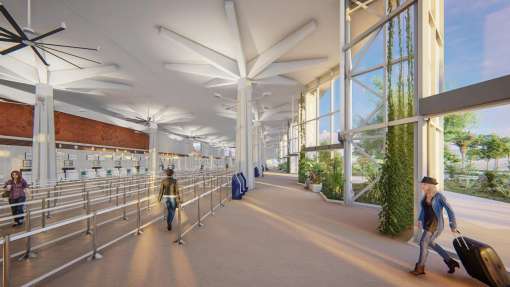
In the second phase of development of Reunion’s Roland Garros Airport, the southern façade of the existing terminal will be moved to enlarge the check-in hall. This relocation will take place at the same time as the creation of a landscaped esplanade. It will increase the surface area of the check-in hall, ensuring that passengers are less densely packed, providing pedestrians with a safe area that is naturally cooled by the surrounding vegetation. Particular attention has been paid to the design of the outdoor facilities, which have a direct impact on the well-being of passengers and their entourage. There was also a keen desire for the airport's architecture to blend in well with Reunion's landscapes.
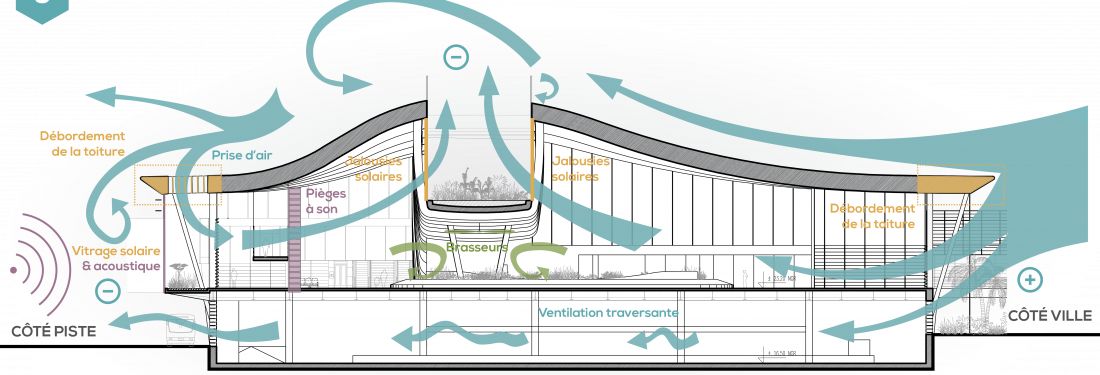
Natural ventilation
An architecture shaped by the trade winds themselves! The principle of natural ventilation is designed to reduce the energy costs associated with air conditioning by restricting its use to enclosed spaces, either for functional or safety reasons. The airport site is constantly exposed to trade winds blowing from north-east to south-east, making it possible to install a natural ventilation system. This involves developing air flows at speeds of between 0.5 m/s and 1.5 m/s to increase the exchange of heat between the human body and the outside world. By doing this, the system reduces the perceived temperature by around 5 degrees, bringing the body back into its comfort zone of between 19 and 28 degrees. Thanks to the L shape formed by the new terminal and the existing building, the air flow intake system is fitted to the east facade, which is under excess pressure. The roof forms the outline of a wave, and at its peak there is the 130m long climatic ‘canyon’ running perpendicular to the eastern section, acting as a powerful low-pressure extraction pump. Towards the western section there is the low-pressure wake for the entire building. The pneumatic connection (thanks to the open spaces indoors running from the east to the west facade and along the low-pressure canyon) naturally creates balanced internal ventilation flows. By controlling the louvres on the east facade, the dynamic nature of varying wind flows can be regulated depending on external climatic conditions, including rainfall. To make use of winds from the north-east, an emergent low-pressure well connected to the canyon is installed on the north facade, providing the same internal airflow crossing the hall as for the east to south-south-east flows. Whatever the wind direction, thermal comfort is guaranteed, with airflow speeds of around 1 m/s and air renewal rates in excess of 30 vol/h. Thermal relief, which requires air renewal rates of 15 vol/h, is always guaranteed, as are hygienic air renewal rates. In some areas where only thermal relief is required, thermal comfort can be achieved by turning on fans. The aerodynamic and ventilation design of the building’s architecture makes Roland Garros Airport a fine demonstration of bioclimatic design.
A hollow-core floor to save on concrete
The floor of the New West Terminal was built using a hollow-core construction method, an innovative technique that has saved concrete and reduced the size of the beams supporting it.
The New West Terminal will be on one single floor, covering level 0, which will be walked on by passengers collecting their baggage on arrival. The structure was initially planned to be made of traditional reinforced concrete, before SBTP-SOGEA, the company in charge of the structural work, proposed a hollow-core solution to the airport. This technique, which is currently being developed in Europe and has only been used once in Reunion (at the Decathlon shop in Commun Primat), involves placing hollow plastic caissons within the floor structure itself. This saves on concrete, reducing not only the weight of the floor but also the size of the beams between the load-bearing columns. This considerable reduction in the number of floor-supporting beams is also a considerable advantage when the building is in use, as it makes it much easier to gain access to the various networks already connected under the floor.
What's more, this method of construction is also quicker to install than when pouring concrete for a traditional floor, and the estimated saving in concrete is 140 m³.
The terminal floor boasts another special feature: it has not been given any cladding, leaving a smooth concrete surface with a rough, mineral appearance. To ensure its durability and longevity, the surface has been coated with a protective layer of quartz powder in order to harden the top layer of the slab, which will be walked on by passengers and their baggage trolleys. As the floor is polished over time, it will take on a uniform mineral sheen.
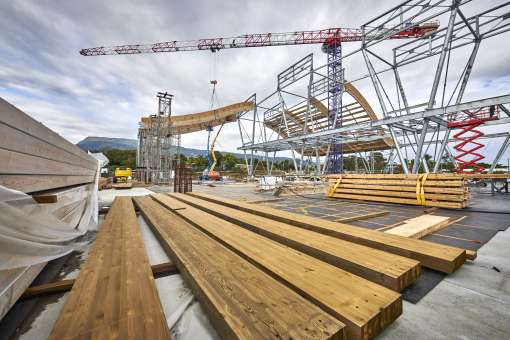
Metal and glulam frameworks
Beyond the obvious architectural and technical aspects of this complex framework, the use of wood was preferred in order to reduce the environmental impact of this building's construction.
Red pine from PEFC-certified Scandinavian forests was chosen. The wood has been treated in a class IV autoclave, and the visible parts will be treated with wood stain.
The 750 m³ of timber are essentially made up of 275m³ of glulam beams for the main structure. A significant proportion of the secondary structural elements, 326m³, was processed locally by FIBRE, a local partner of ARBONIS, a mainland France subsidiary of VINCI and the main player in the timber frame construction business.
The largest part of the structure is a crossbeam weighing 6.7 tonnes, 2.50m high and 25m long. It was transported from mainland France by ship, and delivered to the site by special convoy. This element will form the longest span of the structure, coupled with 2 other beams weighing 6t and 4.5t.
Facade louvres
51% (or 1516m²) of the façade is made up of motorised openings, an improved version of traditional louvered windows, known locally as ‘nacos’. A tropical version has been specifically developed by the German manufacturer for the New Terminal project (which we like to think of as simply a high-tech version of our nacos! 😊).
This device, which allows the façade to be porous, is an essential part of the natural ventilation process.
The project will include more than 3,000m² of these openings, which will be continuously controlled by a dedicated, centralised computerised climate management system.
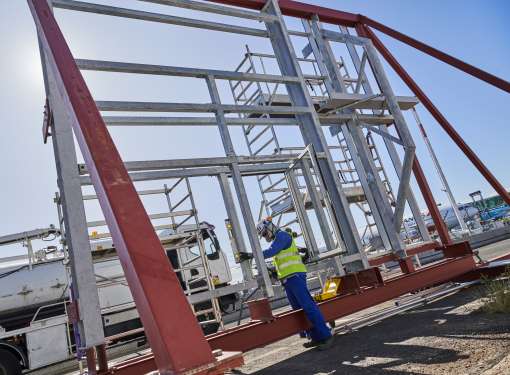
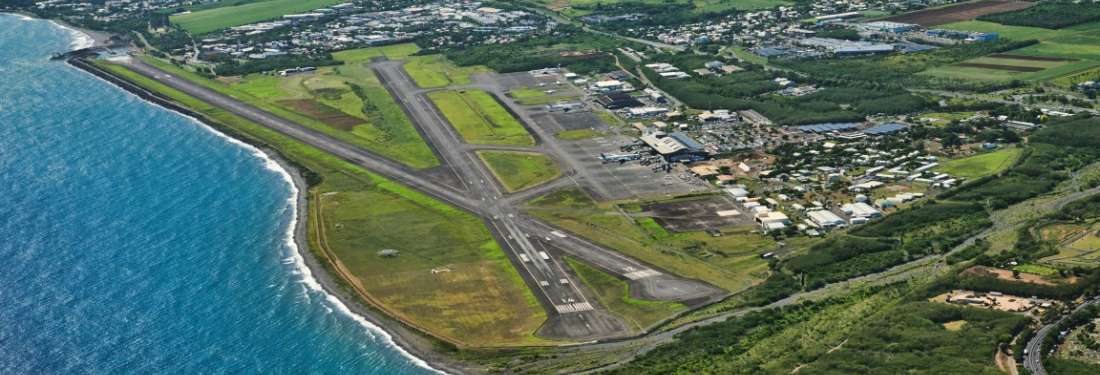
Developing Reunion’s Roland Garros Airport, a challenge for the island
Co-funded by the European Union, this extension project will enable the development of regional and international passenger connections to increase the competitiveness of the airport, a recognised European hub for the Indian Ocean and the southern hemisphere.
The New West Terminal project is fully aligned with the following 3 pillars of Sustainable Development:
- - Economic development: with its increased capacity, the terminal is designed to handle 3 million passengers during its first phase. This capacity will provide the region with greater prospects for further development, particularly in terms of tourism, and will help to generate significant business for the whole of Reunion's economic sector.
- - Environmental development: the design of the New West Terminal is based on the specific characteristics of Reunion's climate. Its concept is based on natural ventilation, to help ventilate and cool the interior of the terminal using an ingenious system of louvres and low-pressure wells, thus avoiding the use of air conditioning throughout the passenger reception area.
- - Societal development: in order to ensure that the project is part of a virtuous circle of professional integration, a partnership has been set up with Pôle Emploi (national employment agency) to promote professional integration. At the same time, this construction project has made it possible to help local companies and SMEs to play an active part in this emblematic project for Reunion.
Local companies hard at work
With a view to contributing to activity in Reunion's construction and public works sector, Société Aéroportuaire has allocated contracts for the construction of the New West Terminal to ensure that local SMEs may participate. 91% of the companies selected are local, and 72% are SMEs. A partnership has also been set up with Pôle Emploi (the national employment agency) to encourage companies to work with people who have been excluded from the labour market, providing over 20,000 hours of work experience on the site.
Supporting job creations
20,000 hours have been contracted with Pôle Emploi. It is estimated that between 1,500 and 2,000 direct and indirect jobs will be required during the works.
Overall, Reunion’s Roland Garros Airport employs nearly 270 staff, with on-site activity generating more than 3,200 direct jobs each year and supporting 18,600 other jobs indirectly (i.e. 6% of jobs on the island according to a socio-economic study carried out in 2018). The aeronautical sector's contribution to local GDP, via the airport, is €816 million, or 4% of the island's GDP.
Safeguarding the biodiversity on the airport grounds
In order to reconcile airport activity with the protection of protected species during the major works phases, Société Aéroportuaire undertook a 3-year inventory of the biodiversity of the airport premises alongside the association Aéro Biodiversité.
This inventory of all species present on-site (fauna, flora and insects) was essential in order to be able to define and implement the appropriate measures and systems to avoid or at least reduce the impact of the construction work on the fauna and flora to be found on the airport grounds.
For each worksite, an environmental charter was drawn up, added to the contracts as an appendix and then signed by the contractors.
This charter governs waste management, general disturbances and respect for flora and fauna on our site.
Since 2012, Reunion’s Roland Garros Airport has been taking part in the ‘Nights without Lights’ operations specifically aiming to protect endemic petrels, and has been working on the installation and orientation of new lighting that will have less impact on fauna (ULOR zero and LED temperature) under an agreement with SEOR (Reunion Society for Ornithological Studies), including site lighting during construction work at night.
Protecting bats
In partnership with the DEAL (Department for the Environment, Planning and Housing), Société Aéroportuaire is committed to preserving the small free-tailed bats on the airport grounds, including those of the Taphozous genus. There has always been a colony of small free-tailed bats nesting on the west side of the existing terminal building, and a colony of Mauritius Tomb Bats is currently located on the roof of the west side of the terminal building. A specialist consultant monitored this colony of small free-tailed bats and Mauritian tomb bats for an entire year before any work began. The idea was to count the number of individuals and find out about their habits in order to prevent any possible impact on their way of life. A protection perimeter has been in place since work began on the New West Terminal.
The preservation of species and synergy with the existing environment were fundamental principles when it came to designing and building this new west terminal.
All work carried out within this perimeter has undergone modifications in order to minimise any impact on our winged friends - and there has already been one birth since the work began, a sign that the colony is doing well!
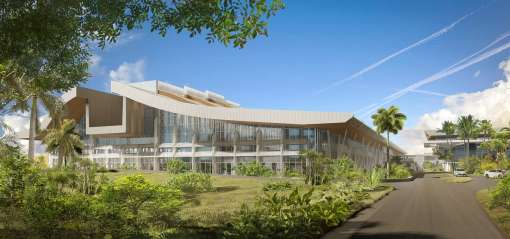
Planting around the New West Terminal
A total of 4,247 plants are scheduled to be planted, including 1,000 trees and palms of 108 different species, which will in turn enrich the array of vegetation already welcoming passengers on their arrival.
The airport works in collaboration with the National Park to choose the right species of trees and plants in order to create an assortment of plants made up of endemic species to be planted on the airport grounds as part of all our major projects.
A contract has been signed with a nursery in Sainte-Marie to ensure the supply of good-sized endemic trees and to guarantee their origins.
A rainwater management technique based on temporisation/infiltration has been chosen in order to return as much water as possible to the groundwater table by creating drainage channels and an infiltration basin that will ensure that trees will grow correctly in our Jardin Des Remparts, a garden located to the west of the new building.